
 undiffused
light to form a virtual
image of any object
placed in front of it.
undiffused
light to form a virtual
image of any object
placed in front of it.
Ancient and primitive mirrors were
typically made of polished stone (obsidian in Stone Age Turkey, and jet in Pre-Columbian Peru), perhaps wetted to make them more reflective, and then metal (copper, bronze, silver, tin, etc.) In the 16th century, Venetian and French glassmakers developed a process in which transparent glass is coated with mercury (to the back side). Processes using an alloy of silver are most often used in manufacturing contemporary mirrors, but several materials — a number of metallic, ceramic, ![]()
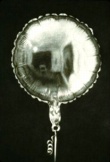 and plastic surfaces for mirror applications (aluminum and chrome, and
and plastic surfaces for mirror applications (aluminum and chrome, and Mylar® are among these) — offer such highly reflective qualities, that artists and designers employ them for their durability, flexibility, lightness, economy, tolerance of heat, cold, and so on.
Most ![]()

![]() mirrors are flat. Concave, convex, and otherwise curved and beveled surfaces are also mirrored for enlargement, inversion and other sorts of distortion.
mirrors are flat. Concave, convex, and otherwise curved and beveled surfaces are also mirrored for enlargement, inversion and other sorts of distortion.
A "mirror image" is an image that is identical to another one, except that its parts are reversed from left to right, as they would appear in a mirror.
![]()

Whether hand-held, wall-mounted, or standing, most mirrors have been placed in frames.
A mirror is sometimes called a "speculum," "looking glass," or simply a "glass."
Metaphorically, something is called a mirror when it faithfully reflects or gives a true likeness of something else.
Mirrors ![]()
 provide readily available images of a viewer that match what others see. The self-consciousness they encourage can lead either to fruitful introspection or to unfortunate vanity.
provide readily available images of a viewer that match what others see. The self-consciousness they encourage can lead either to fruitful introspection or to unfortunate vanity.
Until the invention of photography, mirrors served as the indispensible means to artists' using themselves as models for self-portraits.
Mirrors ![]()
 have been potent props in allegories,
and are often identifed as attributes
of various gods and saints, virtues, senses, and vices. They have
been employed as symbols for a
wide range of things — of truth,
self-knowledge, sight, pride, vanity,
and lust.
have been potent props in allegories,
and are often identifed as attributes
of various gods and saints, virtues, senses, and vices. They have
been employed as symbols for a
wide range of things — of truth,
self-knowledge, sight, pride, vanity,
and lust.
Mirrors have been associated with divination in many cultures. In recent times visual phenomena purported to result from magic or miracle have often been described as trickery — as illusions produced (whether actually or metaphorically) by mirrors, or by "smoke and mirrors." If those presenting these exhibitions don't misrepresent their works as the products of some metaphysical form of nature, do audiences embrace them as works of art?
Examples of mirrors and mirrors in art:

Greece, Caryatid Mirror, c. 470 BCE,
bronze, height 42 cm, diameter
mirror disc 17.5 cm, George Ortiz collection. This is allegedly
from Dodona, North-East Peloponnese, Sicyon? See caryatid
and Greek art.
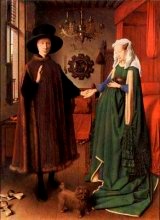
Jan van Eyck
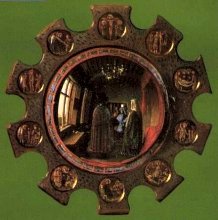 (Dutch, died 1441), The
Arnolfini Marriage [aka Giovanni Arnolfini and his Wife],
1434, oil on wood
panel, 81.8 x 59.7 cm, National
Gallery, London.
(Dutch, died 1441), The
Arnolfini Marriage [aka Giovanni Arnolfini and his Wife],
1434, oil on wood
panel, 81.8 x 59.7 cm, National
Gallery, London. A convex mirror hangs on the wall behind the bride and groom. In this mirror is a reflection of the scene in the room. It was probably made in Venice from a blown bubble of glass, cut during the annealing process, backed with a coating of mercury, and mounted in a frame bearing ten rondels, each portraying a scene from the life of Christ. See convex, Dutch art, and symbol.

Italian (Siena?), Mirror
Frame, c. 1490-1500, carved
and gilt poplar frame, height
24 1/4 inches (61.6 cm), width
13 7/8 inches (35.2 cm), diameter
circle 6 inches (15.2 cm), Metropolitan
Museum of Art, NY. See tondo.
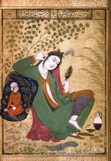
Riza-i 'Abbasi (Persian, active 1587-1635), Safavid Dynasty, Woman with a Mirror, 1619, opaque watercolor on paper, 24.1 x 12 cm (9 1/2 x 4 3/4 inches, Detroit Institute of Arts. See Islamic art.

Diego
Velázquez (Diego Rodríguez de Silva y Velázquez)
(Spanish, 1599-1660), The
Family of Philip IV, or "The Maids of Honor (Las Meninas)", c. 1656, oil
on canvas, (318 x 276 cm),
Prado Museum, Madrid.
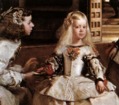 This
is a group portrait
of an exceptional sort:
This
is a group portrait
of an exceptional sort:
In the center-foreground
is the infanta (princess) attended by her meninas
 (maids
of honor) — companions including two young ladies, a dwarf,
a child, a dog, a nun, and a tutor.
(maids
of honor) — companions including two young ladies, a dwarf,
a child, a dog, a nun, and a tutor.
This little party is visiting the studio
where Velázquez stands before his canvas. We see the back of it, perched upon
an easel. The painter and
 most of the others
look toward the king and queen as they pose for the painting
in progress.
most of the others
look toward the king and queen as they pose for the painting
in progress.
The king and queen would not actually be
visible in this picture if their reflected
image could not be seen in a mirror placed on the opposite
wall. Altogether this is a view, which could only be seen by
the king and queen themselves, as
 they pose for their portrait. The point
of view of every person who gazes
upon this painting is that of the king and queen of Spain. A
very privileged vantage indeed!
they pose for their portrait. The point
of view of every person who gazes
upon this painting is that of the king and queen of Spain. A
very privileged vantage indeed!
Further
increasing the sense that we are present at a specific moment
is our glimpse of a man in the distant doorway, pausing as he
descends or ascends — either entering or exiting the chamber.
See Baroque, genre, self-portrait,
and Spanish art.
Charles Le Brun and Jules Hardouin-Mansart (French architects), Galerie des Glaces, 1678-1684, 10.5 x 12.3 x 73.0 m, Château de Versailles. Once large plates of glass could be produced in the 17th century, entire walls and rooms were panelled with large plates of mirror-glass, the most elaborate example being the Galerie des Glaces in the great palace of King Louis XIV. See coffer and parquetry.
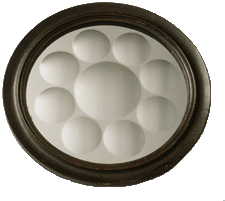
French, 1700s, Miroir de sorcière (Sorceress's mirror),
a "multiplying mirror," mercury-coated glass in oak frame,
diameter 7 5/8 inches,
Getty Research Institute. This is one of 22 devices in the Devices
of Wonder exhibit catalogued online by the Getty Museum — best seen with Flash and RealAudio plugins.
![]()
English, Pier Glass, 1750, mirror in a gilt
wood frame, 89 x 35 1/2 inches, Minneapolis Institute
of Arts.

Honoré Daumier (French, 1808-1879),
A French Painter Paints Himself (Un français
peint par lui-meme), no. 3 from the series Scénes
d'ateliers, 1848, lithograph,
image 23.5 x 19.7 cm; sheet 34 x 26.2 cm, Fine Arts Museums of
San Francisco, CA. This is not actually a self-portrait, but instead a caricature of a type — "French
painter" — who examines his reflection while painting a self-portrait. See Realism.
![]()
Jean-Désiré-Gustave Courbet
(French, 1819-1877), Jo, La Belle Irlandaise (Johanna Heffernan, born
1842/43), 1866, oil
on canvas, 22 x 26 inches
(55.9 x 66 cm), Metropolitan Museum of Art, NY.
Dante Gabriel Rossetti (English, 1828-1882), Lady Lilith, 1867, watercolor, bodycolor and gum, 20 3/16 x 17 5/16 inches, Metropolitan Museum of Art, NY. See Pre-Raphaelite Brotherhood.

Hilaire-Germain-Edgar Degas (French, 1834-1917),
The Dancing Class, probably 1871, oil on wood
panel, 7 3/4 x 10 5/8 inches (19.7
x 27 cm), Metropolitan Museum of Art, NY. See dance
and Impressionism.

Pierre-Paul-Léon Glaize (French, 1842-1932), Before the Mirror, 1873, oil on canvas, 39 3/4 x 29 7/8 inches (101 x 75.9 cm), Metropolitan Museum of Art, NY.

Pierre Bonnard (French, 1867-1947), Self-Portrait in the Bathroom Mirror,
1939-1945, oil on canvas,
73 x 51 cm, Georges Pompidou Center, Paris. See Intimisme
and self-portrait.
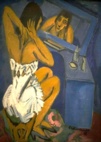
Ernst Ludwig Kirchner, (German, 1880-1938), Woman at the Mirror, 1912, oil on canvas, 29 x 29 inches, Musee Nationale d'Art Moderne (Centre Pompidou), Paris. See Expressionism and German art.
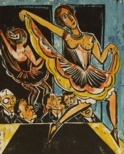
Max Pechstein (German, 1881-1955), Dancer Reflected in a Mirror, 1923, woodcut,
edition of 51, 19 9/19
x 15 3/4 inches (49.6 x 40 cm), Museum of Modern Art, NY. Publisher:
Euphorian Verlag, Berlin. See Expressionism and German
art.
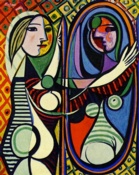
Pablo Picasso (Spanish, 1882-1973), Girl Before a Mirror, 1932, oil on canvas, 64 x 51 1/4 inches, Museum of Modern Art, NY. See Cubism.

Paul Delvaux (Belgian, 1898-1994), Femme au Miroir, 1945, oil on Masonite, 35 3/4 x 31 inches, Minneapolis Institute of Arts. See Surrealism.

Maurits Cornelis Escher (Dutch, 1898-1972), Hand with Reflecting Sphere, 1935, lithograph, 32 x 21.5 cm. See self-portrait and sphere.

Brassaï (French, born Transylvania, 1899-1984), Couple d'amoureux dans un petit café, quartier Italie, c. 1932, printed c. 1970, depicted: Paris, France, gelatin silver print, 28.3 x 22.7 cm (11 1/8 x 8 15/16 inches), Metropolitan Museum of Art, NY. See photography.

Herbert Bayer (Austrian, 1900-1985, worked in USA), Self-Portrait in Mirror, 1932, gelatin-silver print, 13 7/16 x 9 3/4 inches (34.13 x 24.77 cm). See self-portrait and Surrealism.

Moltrasio (Italian graphic designer) for Paglieri Velluto di Hollywood (cosmetic manufacturer), Woman with Powder Compact, 1950s, poster, offset lithography, 12 x 8 1/2 inches. See advertisement, feminism, and gaze.

Michelangelo Pistoletto (Italian, 1933-), Broken Mirror, 1978, mirror with gilded frame, two pieces, 64 3/8 x 53 1/8 x 3 1/8 inches and 23 5/8 x 23 5/8 inches. Solomon R. Guggenheim Museum, NY.
![]()

Also see  anamorphosis,
appropriation, camera, camera
lucida, camera obscura,
copy, counterfeit,
facsimile, fake, feng shui, foil,
forgery, kaleidoscope,
lens, optical, positive,
representation, reproduction, simile,
simulacrum, and simulation.
anamorphosis,
appropriation, camera, camera
lucida, camera obscura,
copy, counterfeit,
facsimile, fake, feng shui, foil,
forgery, kaleidoscope,
lens, optical, positive,
representation, reproduction, simile,
simulacrum, and simulation.

https://inform.quest/_art